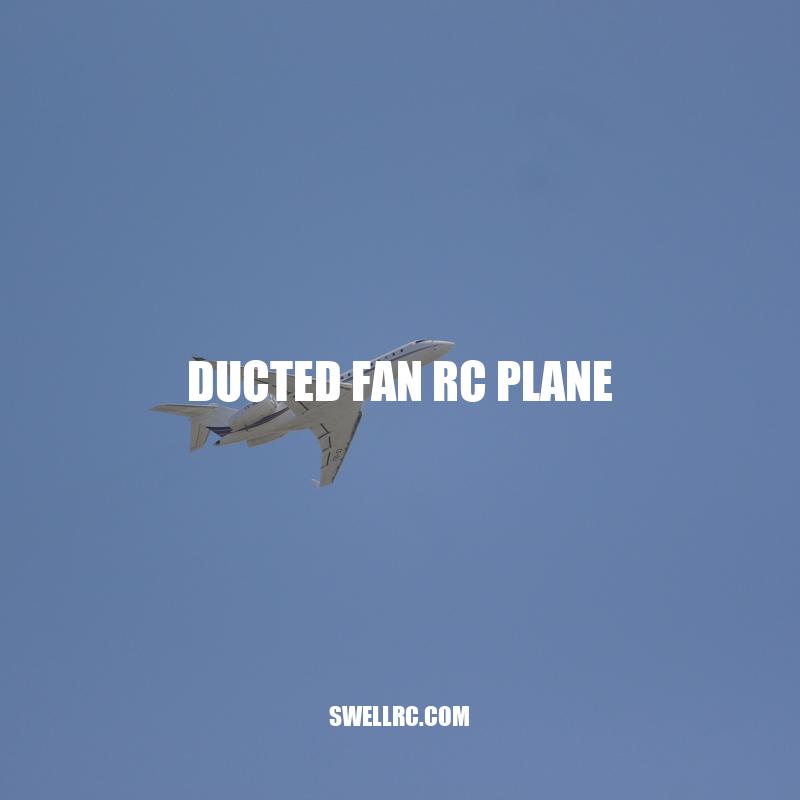Ducted Fan RC Planes: Benefits, Build Process, and Flying Tips
Ducted fan RC planes are a unique and exciting innovation in the world of remote-controlled aircraft. Unlike traditional propeller-driven planes, ducted fan planes use a shrouded fan to produce thrust, which results in increased efficiency and reduced noise. This technology is used in a variety of real-life applications, such as jet engines and cooling systems, making it a proven and reliable option. For RC enthusiasts, ducted fan planes offer a range of benefits, including increased power, speed, and stability. However, building and flying a ducted fan RC plane does require some specialized knowledge and materials. In this article, we will explore the world of ducted fan RC planes, including how they work, the materials needed to build one, and tips for successful assembly and flight. Whether you’re a seasoned RC pilot or just starting out, ducted fan planes are an exciting opportunity to take your skills to the next level.
How Ducted Fan Technology Works
Ducted fans, like jet engines, suck air into the system which is then accelerated through a nozzle. Air acceleration occurs at the expense of pressure energy, which is converted into kinetic energy and results in increased thrust. Here’s how the technology works:
- Instead of a traditional open blade, a ducted fan has a shroud that encloses the blades.
- The shroud helps to shroud the fan blades from the outside air.
- The fan blades are located in a tube or duct surrounded by the shroud.
- A motor drives the fan blades, which sucks air through the duct and compresses it, before expelling it out of the back of the plane.
Ducted fan technology can be seen in various real-life applications including wind tunnels, cooling systems, and hovercrafts. Hobbyist ducted fan RC planes typically use brushless electric motors which are less powerful, but quieter and more efficient. One popular ducted fan RC plane is the E-flite Habu which is known for its speed and agility. If you are interested in purchasing one, several online retailers offer ducted fan RC planes for sale, such as Horizon Hobby and Motion RC.
Are ducted fans better than normal fans?
Ducted fans – many think of them as futuristic and cool, but are they really better than normal fans? Well, to put it simply – yes! The ducted fan’s design is what makes it so efficient and advantageous. The duct surrounding the fan increases the thrust efficiency by up to 90% in most cases, in comparison to a similar-sized propeller in free air. This efficiency not only gives the ducted fan an edge over a normal fan, but it also makes it a great choice for more complex applications like drones and RC planes.
But wait, there’s more! The ducted fan also has another trick up its sleeve – it’s quieter than a normal fan. This makes it a great option for those who don’t want to be disturbed by a noisy fan while they’re working or sleeping. Additionally, the ducted fan offers good opportunities for thrust vectoring, which means an even greater level of control over the direction and strength of the air being blown. These multiple features make the ducted fan far superior to a normal fan in many applications.
So next time you’re choosing a fan, whether for a DIY project or for personal use, consider the advantages of a ducted fan. With its increased efficiency, quiet operation, and ability for thrust vectoring, it’s sure to be a top performer in any setting.
Using ducted fan technology on an RC plane has numerous benefits over traditional propellers. Here are some of the advantages:
| Advantages: | Explanation: |
|---|---|
| Increased Power | The ducted fan is more efficient in converting the power into forward thrust. It enables the plane to fly fast and gain altitude at a faster rate. |
| Noise Reduction | Because the blades of a ducted fan are enclosed in the shroud, they generate much less noise than open propellers. This feature makes it an excellent choice for flying in residential areas or quieter spaces. |
| Increased Stability | The shroud guides air over the blades to provide some of the gyroscopic effect that keeps the aircraft stable. This stability can be especially beneficial in less than ideal flying conditions like wind or other turbulent air currents. |
In addition to these advantages, ducted fan RC planes are typically faster and more aerodynamically efficient than traditional prop planes. The ducted fan design allows for a smaller, more streamlined body and wing shape to be used, which provides less drag and greater maneuverability. This can be particularly useful for advanced maneuvers like rolls, loops, and inverted flight. A well-designed ducted fan plane is sure to turn heads at the flying field and impress other hobbyists.
E-flite, FMS, and Skyangel are some popular brands that offer quality ducted fan RC planes. Online retailers like Motion RC offer an extensive collection of ducted fan RC planes, parts, and accessories at an affordable price.
What is the advantage of RC plane?
RC (radio-controlled) planes have become increasingly popular among hobbyists, both young and old. They are mainly used for recreational purposes and by beginners in aero flying. These planes can provide a sense of thrill and excitement like no other. Imagine having the power to control a model plane soaring through the sky with your own radio transmitter. This alone can be enough to captivate the attention of anyone interested in aviation.
Apart from offering endless hours of fun, RC planes also have additional advantages. One huge benefit is that they can foster creativity and practical skills when constructed within the comfort of your home. Building an RC airplane from scratch can be a great way to refine your concentration, hand-eye coordination, and construction skills. It provides an excellent opportunity to learn about physics, aerodynamics and engineering principles.
RC planes are also much cheaper than drones, which is another significant advantage. With the right kit, building an RC plane can cost significantly less than buying a drone. Drones are packed with advanced features, electronics and sensors that account for their high cost, making them prohibitively expensive for beginners and casual hobbyists.
Overall, RC planes provide an excellent gateway into the world of aviation, allowing enthusiasts to embrace their passion and creativity while enjoying a thrilling experience.
Materials Needed to Build a Ducted Fan RC Plane
Building a ducted fan RC plane may seem like a daunting task, but with the right materials and resources, it can be a fun and rewarding experience. Here are some essential materials you’ll need to get started:
- Ducted Fan Unit: You can purchase quality ducted fan units from brands like E-flite, Freewing, and Exceed RC.
- Foam Board or Balsa Wood: Your RC plane’s structure can be built from lightweight materials like foam board or balsa wood.
- Electronic Speed Controller (ESC): An ESC is a crucial component that controls the speed of your ducted fan. You can find suitable ESCs from brands like Hobbywing and HobbyKing.
- Radio System (transmitter and receiver): A reliable radio system helps you control your RC plane’s movement. You can find suitable radio systems on popular retailers like Amazon and RC Planet.
- Battery: You’ll need a suitable battery to power your RC plane. Brands like Spektrum and Tattu offer quality batteries that are compatible with RC planes.
- Servos: Servos help control your RC plane’s movement. Brands like JR and Futaba are popular choices for reliable servos.
- Cables, connectors, and wire: You’ll need to purchase cables, connectors, and wires to connect the various components of your RC plane together.
- Hot Glue Gun: A hot glue gun can be useful for assembling various components of your RC plane together.
It’s important to note that the specific components you’ll need may vary depending on your design and flight requirements. Make sure to consult your RC plane plans or online resources for additional guidance on selecting the right components.
When working with tools and components, it’s essential to take safety precautions. Wear protective eyewear, gloves, and follow the manufacturer’s instructions carefully. With patience, careful planning, and a bit of creativity, building your ducted fan RC plane can be a fun, rewarding experience that offers hours of enjoyment.
What materials do you need to make an RC plane?
To make an RC plane, you would need a variety of materials that depend on the type of plane you wish to build. However, some commonly used materials include foam board, balsa wood, carbon fiber rods, servos, control horns, batteries, and a motor. These materials are essential to build the plane’s structure, provide flight control, and power the aircraft.
Foam board is the most popular material used to construct the frame of an RC plane. The board is sturdy and lightweight, making it easy to work with. For wings and other intricate parts, balsa wood can be used due to its strength and ability to bend.
To give the airplane stability during flight, carbon fiber rods are used. These rods are strong enough to bear the weight of the plane, yet light, making them ideal for constructing the frame.
The servos are essential components used to control the movement of an RC plane. They facilitate the movement of control surfaces such as ailerons and elevators, which are attached to control horns, mounted on the plane’s structure.
Batteries are a vital component to power the motor and servos. Depending on the size and type of the plane, you may need to choose a battery with higher voltage and amperage ratings to provide sufficient power supply.
In conclusion, creating an RC plane requires a range of materials, and each plays an essential role in constructing the aircraft. Using the right materials can make all the difference in the plane’s durability, stability, and ability to fly smoothly.
How to Assemble a Ducted Fan RC Plane
After gathering all the necessary materials, it’s time to start assembling your ducted fan RC plane. Here’s a basic step-by-step guide to get you started:
- Cut out your foam board or balsa wood pieces according to your plans.
- Sand or file the edges of the pieces to ensure they fit together smoothly.
- Attach the ducted fan unit to the body using hot glue or tape.
- Install the electronic speed controller (ESC), receiver, and servos according to the manufacturer’s instructions.
- Connect the cables, connectors, and wires ensuring proper connections.
- Test each component before final assembly.
- Attach the battery.
- Turn on the radio system and test the throttle, elevator, and aileron controls.
Along the way, you may encounter challenges or questions, so it’s always best to consult online resources like video tutorials or forums for additional guidance. Some popular online resources for ducted fan RC planes include:
- RCGroups.com: A popular forum for RC hobbyists that includes a dedicated section for ducted fan RC planes.
- Flite Test: A website that offers a wide range of RC plane plans, including several ducted fan designs.
- Parkjets.com: A website that features a variety of downloadable plans for RC planes, some of which use ducted fan technology.
Remember, assembling your ducted fan RC plane may take some time and patience, but the end result will be worth it. Enjoy the process and have fun flying your new creation!
What are the basics of a ducted fan?
A ducted fan is a popular device used in aviation and model making industries to produce propulsion or lift. This device has three significant components that work together to create thrust. The propeller or fan is the first component that helps move air and produce lift. The next component of a ducted fan is the duct or shroud, which surrounds the fan and serves as a protective shield. It also enhances the efficiency of the fan by reducing the turbulence of the surrounding air. Lastly, we have the engine or motor, which powers the fan and drives the propeller to rotate, producing thrust. These three components make up the basics of a ducted fan, and they work together to ensure that the device functions successfully.
Tips for Flying a Ducted Fan RC Plane
Flying a ducted fan RC plane can be an exciting and rewarding experience, but it’s important to make sure everything is properly aligned and calibrated before taking off. Here are a few tips to keep in mind when operating your ducted fan RC plane:
- Find an open and safe area to fly. Avoid populated areas, power lines, and trees.
- If you’re new to flying, consider practicing with a simulator or finding a local RC club to help you get started.
- Begin with a low throttle and gradually increase the power as the plane gains altitude.
- Use small, gradual movements to control the plane’s pitch, roll, and yaw. Avoid jerky or sudden movements, which can destabilize the plane.
- Keep an eye on the plane’s battery life and return to the ground before it runs out of power.
- Practice turning and landing the plane, as these can be some of the trickiest maneuvers to master.
As you become more experienced with flying your ducted fan RC plane, you may want to experiment with more advanced control settings or aerobatic maneuvers. Just remember to always prioritize safety and fly in accordance with local laws and regulations.
If you’re interested in purchasing a ducted fan RC plane, there are many online retailers that sell pre-built models. Some popular options include:
HobbyKing: Wide selection of ducted fan planes at low prices.
Tower Hobbies: Large inventory of popular brands and models.
Horizon Hobby: Specializes in high-quality, advanced ducted fan planes.
With the right skills and equipment, a ducted fan RC plane can provide hours of fun and excitement. Whether you choose to build your own or purchase a pre-built model, enjoy the thrill of taking to the skies with this innovative and dynamic technology.
Is flying RC planes fun?
Flying RC planes can be an incredibly enjoyable and thrilling experience. Whether you are a seasoned RC pilot or a beginner, you’ll undoubtedly love the sensation of flying your remote-controlled plane through the skies.
There are numerous benefits to flying RC planes that make it such a popular pastime for people of all ages. For one, it’s an excellent way to unwind and relax while enjoying the great outdoors. Flying RC planes provides a sense of freedom that lets you escape from the stresses of daily life and immerse yourself in nature.
Additionally, flying RC planes can help you learn new things and develop various skills. You will need to understand the basics of aerodynamics and physics to pilot an RC plane successfully. And by practicing, you can improve your hand-eye coordination, spatial awareness, and reaction time.
But perhaps the most significant benefit of flying RC planes is the sheer fun of it. Whether you are navigating through obstacles or performing acrobatic stunts, nothing beats the thrilling sensation of piloting an RC plane.
In conclusion, flying RC planes is a fantastic hobby that provides an opportunity to relax, learn, and have fun all at the same time.
Conclusion
In conclusion, if you’re looking for a unique and thrilling way to explore the world of RC planes, a ducted fan RC plane could be the perfect option for you. With their efficient, high-powered technology and sleek design, these planes offer an exciting blend of speed, stability, and agility.
By following the tips outlined in this article, you can ensure a successful build and safe flights. Whether you’re a seasoned RC pilot or brand new to the hobby, there’s never been a better time to try your hand at ducted fan RC planes.
As with any hobby, it’s important to prioritize safety and responsible flying practices. Always check the weather conditions before flying and follow local laws and regulations for RC aircraft. With the right skills and precautions, you’ll be able to soar to new heights and enjoy the thrill of flying with a ducted fan RC plane.



